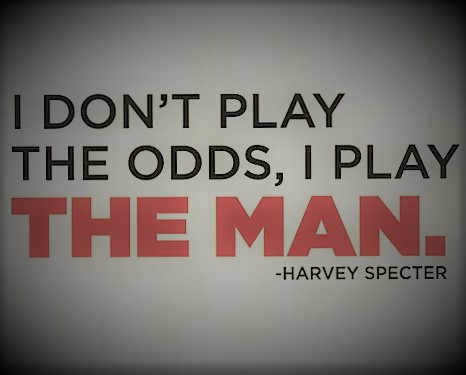I have a confession: I spent the majority of the Easter weekend that’s just passsed, binged-watching on old reruns of “Suits” (psst, don’t tell my mum, who was conscripting for the annual family spring-cleaning fest). Boston Legal and The Good Wife will always be my perennial favourites but by golly, when it comes TV legal eagles, the closer of all closers, Harvey Specter, absolutely blows!
In one episode, Harvey challenges the opposition to a game of poker to win back the company that Harvey’s client had carelessly lost to the opposition in an earlier card game. Harvey’s sidekick, Mike, who has the ultimate photographic memory, offers to play the poker game for him. Harvey rejects Mike’s help with this brilliant one-liner: “I don’t play the odds, I play the man.”
True enough, at the poker game, and in spite of his bad hand, Harvey wins back the company by unnerving the opposition by playing on the opposition’s past and deep insecurities. Harvey’s genius is that he understands that anybody can play the odds at poker (and indeed, life); whether by chance as his gambler of a client did or by logic, as good card players like Mike do. However, what makes a great card player is one, who respects the human element of the game, one that not only reads the play but more importantly, the players.
Great designers read people
Design is a game of poker, where designers are often sitting at cross-roads trying to anticipate and fulfill the ever-changing needs of users, through the use of every logic and / or emotion. Simple as that may appear to be, it can also be downright difficult because you will very often have to challenge the very people that you are serving (and desperately want to please) in order to give them what they really need.
Jennifer Aldrich, in her post about “Good Designers vs Great Designers“, tells the story of a designer friend, whose mentor in what appeared to be rather brazen move, had stood up against a client’s brief. The mentor challenged the brief, albeit diplomatically, which while detailed in its design requirements, was absent on the client’s goals. When questioned on his approach, the mentor had these wise words to say:
I wasn’t standing up to them, I was making sure that I clearly understood the problems that they need to solve. Good designers take orders and hand over exactly what a client wants. Great designers dive deep to uncover what a client actually needs.
It is that last line, which resonates most with me, that you have to courageously commit to your client’s success and not just your client. Mike Monteiro wrote about this and the many battles that they have had to “fight” against clients, over years of running a design service, in order to ultimately work together with clients to win the war. In other words, the goal is not to make clients happy, but rather to make them succeed. Go above and beyond to understand what makes them them tick and then, give them what they need – even if they do not know it themselves yet.
And, how do you do that? Well, again, I take leave from the great Harvey Specter:
You do what they or they shoot you, right? Wrong! You take the gun. You pull out a a bigger gun or you call their bluff or you do one of another 146 other things.
Risky, yes, but that is what it takes to be THE DESIGNER (MAN / WOMAN).





